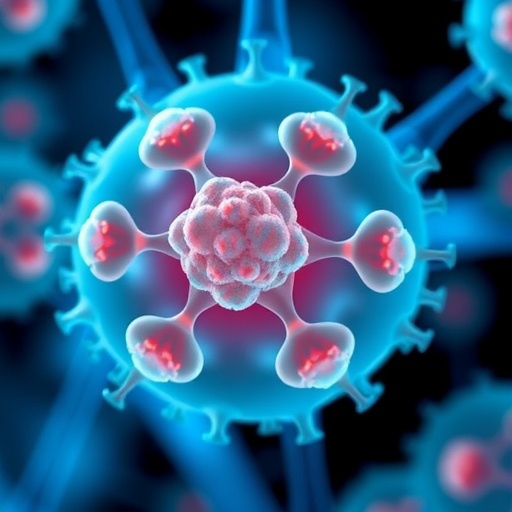The realm of cancer therapeutics is an ever-evolving landscape where the repurposing of existing drugs holds immense promise for accelerating treatment breakthroughs. Among such candidates, auranofin, originally developed and used for its antirheumatic properties, has surfaced as a compelling agent with anticancer potential. However, its clinical translation in oncology has encountered a significant obstacle: serum components inactivate auranofin, rendering it ineffective when delivered systemically. A recent groundbreaking study by Wang et al., published in Nature Communications, elucidates an innovative strategy to overcome this barrier by employing ligand supplementation, which restores auranofin’s anticancer efficacy despite serum inactivation.
The study highlights a critical issue faced in repurposing auranofin for cancer therapy—its biochemical interaction with serum proteins compromises its bioavailability and therapeutic action. This phenomenon, known as serum inactivation, manifests through the irreversible binding of serum thiols and albumins to auranofin, sequestering the drug in a manner that prevents it from exerting its pharmacological effects on malignant cells. Without circumventing this hurdle, the prospects of harnessing auranofin’s unique mechanisms of action—primarily its inhibition of thioredoxin reductase and disruption of redox homeostasis—remain limited.
To address this, Wang and colleagues devised a sophisticated approach hinged on ligand supplementation. Their method involves the administration of specific ligands capable of competitively binding to auranofin or modulating its serum interactions, thereby preventing its premature inactivation. By synthesizing these ligands and determining their binding affinities, the research team demonstrated that strategic ligand supplementation could effectively shield auranofin from the inhibitory effects of serum proteins, restoring its cytotoxic profile against cancer cells in vitro and in vivo.
.adsslot_uEA0gVPqnk{ width:728px !important; height:90px !important; }
@media (max-width:1199px) { .adsslot_uEA0gVPqnk{ width:468px !important; height:60px !important; } }
@media (max-width:767px) { .adsslot_uEA0gVPqnk{ width:320px !important; height:50px !important; } }
ADVERTISEMENT
Mechanistically, auranofin exerts cytotoxicity in cancer cells primarily through the targeted inhibition of thioredoxin reductase (TrxR), an enzyme pivotal for maintaining intracellular redox balance. Inhibiting TrxR leads to the accumulation of reactive oxygen species (ROS), inducing oxidative stress and promoting apoptosis in cancerous cells. However, the drug’s affinity for serum albumin and glutathione causes its early sequestration, which drastically diminishes its therapeutic concentration at tumor sites. The ligand supplementation tactic effectively modulates this interaction, freeing the drug to access and inhibit TrxR in tumor tissues.
The experimental design encompassed meticulous biochemical assays, which confirmed that specific ligands could compete with serum proteins for auranofin binding. High-performance liquid chromatography (HPLC) and mass spectrometry analyses substantiated the formation of ligand-auranofin complexes with enhanced stability, which are less susceptible to serum-mediated inactivation. This biochemical stabilization translated into robust anticancer activity observed in both cell culture models and murine xenografts, affirming the translational potential of the approach.
Moreover, the authors explored the pharmacokinetic ramifications of ligand supplementation, revealing that the modified auranofin formulation exhibited superior bioavailability and prolonged circulation time. This was accompanied by increased drug accumulation within tumor tissue, a critical determinant of therapeutic efficacy. The enhanced pharmacodynamics achieved through this method markedly improved survival outcomes in preclinical cancer models, underscoring the clinical promise of this intervention.
The implications of restoring auranofin’s function extend well beyond a single drug application. This study opens a new avenue in the design of cancer therapeutics where drug inactivation by serum components is a significant limitation. Ligand supplementation may represent a versatile strategy to revitalize other metal-based and small-molecule drugs hindered by similar pharmacokinetic and biochemical constraints, potentially redefining drug delivery paradigms in oncology.
From a chemical standpoint, the work by Wang et al. sheds light on the delicate equilibrium of drug-protein interplay within the bloodstream, a factor often underestimated in drug development. It underscores the necessity of considering not only the intrinsic drug properties but also their extrinsic interactions with the biological milieu. The elucidation of these interactions at a molecular level allows for the rational design of supplementation agents or co-therapies, tailored to modulate these interactions and enhance efficacy.
In addition, the study offers a fresh perspective on exploiting the redox vulnerabilities of cancer cells. By ensuring that auranofin remains pharmacologically active in the presence of serum, the therapeutic window for inducing oxidative stress-mediated cancer cell death can be effectively widened. This approach complements existing strategies targeting the antioxidant defense systems of tumors, potentially augmenting sensitivity to a plethora of combination therapies.
Furthermore, the methodology delineated in the study is adaptable. With advanced analytical techniques, the identification of optimal ligand candidates can be streamlined for various drugs suffering from similar inactivation issues. This stands to benefit not only precision oncology but also other fields where drug bioavailability is critical, such as infectious diseases and neurodegeneration.
The researchers also acknowledged potential challenges, such as the identification of ligands with minimal off-target effects and the optimization of dosing regimens to balance ligand and drug concentrations. Addressing these challenges will be pivotal in translating the promising preclinical results into safe and effective human therapies. Additionally, the long-term implications of ligand supplementation on systemic physiology require thorough investigation to rule out unintended interactions.
Importantly, the study’s multidisciplinary approach—encompassing medicinal chemistry, pharmacology, oncology, and biochemistry—demonstrates the power of integrative research in overcoming entrenched obstacles in drug repurposing. This convergence of disciplines highlights how understanding the nuanced biological context of drug action can refine and revitalize therapeutic strategies, benefiting patients who may otherwise face limited options.
Looking ahead, it will be fascinating to observe clinical trials emerge from this foundation, potentially heralding a new era in which auranofin’s anticancer capabilities are fully realized. Success in clinical settings could inspire the reexamination of other legacy drugs that have been sidelined due to pharmacokinetic limitations, reawakening their therapeutic promises with similar ligand-mediated enhancements.
Finally, this investigation embodies the innovative spirit essential for next-generation oncology treatments. By leveraging a detailed mechanistic understanding and inventive chemical interventions, Wang et al. have presented a strategy that not only revives auranofin’s therapeutic prowess but also broadens the horizon for drug repurposing endeavors worldwide. Their work exemplifies the potential to transform existing pharmacophores into frontline weapons against cancer, a poignant reminder that sometimes, solutions can lie in the overlooked or underutilized facets of drugs we thought we knew.
Subject of Research:
Auranofin repurposing and restoration of anticancer efficacy through ligand supplementation to counteract serum inactivation.
Article Title:
Ligand supplementation restores the cancer therapy efficacy of the antirheumatic drug auranofin from serum inactivation.
Article References:
Wang, Y., Cao, B., Wang, Q. et al. Ligand supplementation restores the cancer therapy efficacy of the antirheumatic drug auranofin from serum inactivation. Nat Commun 16, 7347 (2025). https://doi.org/10.1038/s41467-025-62634-9
Image Credits: AI Generated
Tags: anticancer drug effectivenessauranofin repurposing for cancerbioavailability of cancer drugscancer therapy advancementsclinical translation of cancer therapiesinnovative cancer treatment methodsligand supplementation strategyovercoming drug inactivationprotein-drug interactions in therapyredox homeostasis disruptionserum inactivation challengesthioredoxin reductase inhibition





